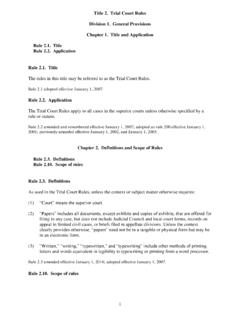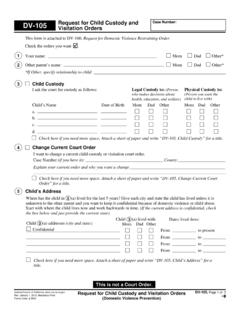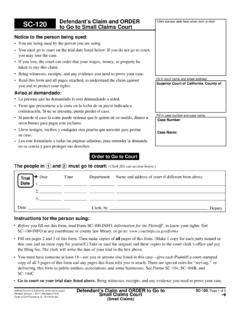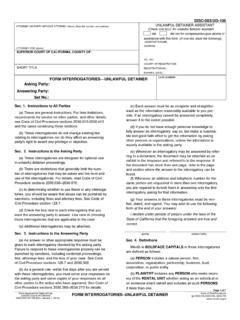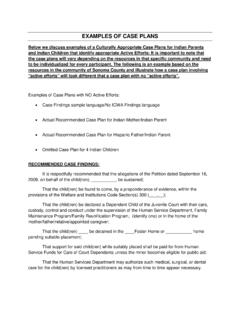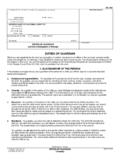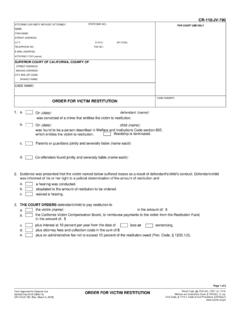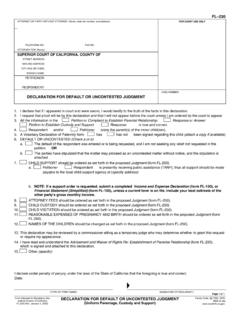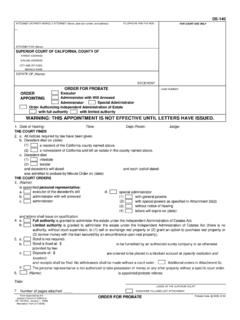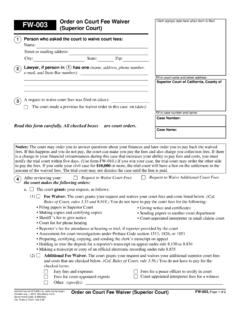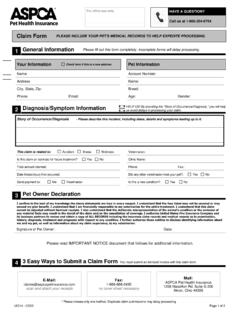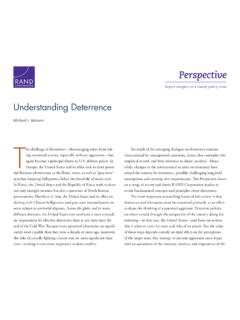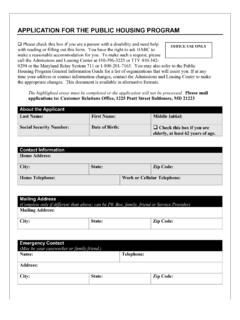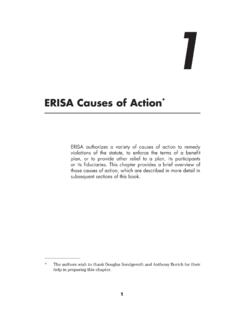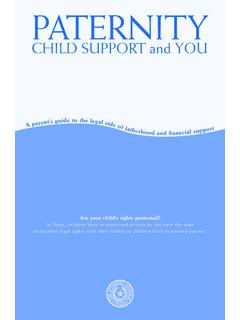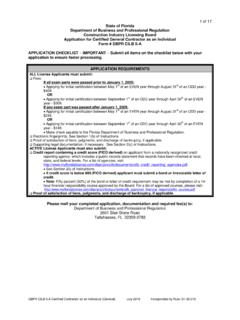Transcription of Court of Appeal - California
1 1 Court of Appeal FOURTH APPELLATE DISTRICT Division One 750 B Street, Suite 300 San Diego, CA 92101 HANDOUT ON WRITS Preliminary Note This handout is intended to assist an attorney or a layperson who may be contemplating filing or responding to a petition for writ of mandate, writ of prohibition or writ of supersedeas. It does not address petitions for writs of review, petitions for writs of habeas corpus or other specialized writ petitions. The Court recognizes writ petitions are frequently prepared in a hurry by attorneys or parties with limited experience in writ procedure and therefore takes a relatively informal approach to processing writ petitions. For example, the Court will treat your petition as having the proper label ( , deem it to be a petition for writ of mandate if you mistakenly prayed for a writ of prohibition) and may call you if a critical part of the record is missing.
2 There are, however, certain requirements that are crucial to success in obtaining writ relief. This handout focuses on these requirements. Prefiling Considerations A writ is a directive from this Court to a trial Court , an administrative agency, or a person to do something or to stop doing something. Unlike appeals, which are heard as a matter of right, writ petitions are generally heard as a matter of discretion, and they are governed by equitable principles. Appellate courts generally grant writ relief only when the petitioner (1) has no other plain, speedy and adequate remedy in the ordinary course of law; an d (2) will suffer irreparable injury if such relief is not granted. If the order, judgment or decision you intend to challenge is directly appealable, you are considered to have an adequate remedy in the ordinary course of law unless you can show extraordinary circumstances ( , a need for immediate relief).
3 Check Code of Civil Procedure section to see what orders and judgments are directly appealable; for rulings not covered by that section, you may also wish to look at the cases dealing 2 with the ruling in question to see if the issue was resolved by an appellate opinion or a writ opinion. The irreparable injury requirement is more difficult to define. It is not established by the mere facts that the challenged ruling is wrong and because of it you will have to spend time and money on unnecessary further litigation. Loss of money damages generally also is not considered irreparable injury. The threatened destruction of one s home or business may constitute irreparable injury, although the threatened foreclosure of unimproved commercial property may not. An order directing release of privileged information, disclosure of attorney work product, or invasion of a protected privacy interest ordinarily will qualify as irreparable injury.
4 You need to judge the circumstances and the severity of the consequences to determine whether you are likely to qualify for extraordinary writ relief. Types of Writs and Time Limits for Filing a Petition 1. Statutory Writs The Legislature has enacted statutes specifying certain rulings may be reviewed by writ petition hence the term statutory writ. (A non-exhaustive list of statutory writs is set out in Attachment A to this Handout.) Statutory writ petitions are often required to be filed within a time prescribed by the statute itself, which is usually short ( , 10 or 20 days). If you fail to meet the statutory deadline, the appellate Court will not have jurisdiction to grant your petition. If a statute authorizes review by writ petition but does not specify a time for filing the petition, the filing period is subject to general principles of laches described in the discussion of Common Law Writs below.
5 Just because the Legislature has authorized review by writ petition does not necessarily mean you have to file a petition to challenge a ruling. In most cases, you may pass on the writ petition and still challenge the ruling on an Appeal from the final judgment in your case. Some rulings, however, may only be reviewed in a writ proceeding. Examples include a denial of a motion to quash service of summons for lack of personal jurisdiction (Code Civ. Proc., , subd. (c)); a ruling on the disqualification of a judge (Code Civ. Proc., , subd. (d)); a ruling on the expungement of a notice of lis pendens (Code Civ. Proc., ); a ruling in a Public Records Act case (Gov. Code, 6259, subd. (c)); and a ruling regarding revocation, suspension or restriction of a medical license (Bus. & Prof.)
6 Code, 2337). 2. Common Law Writs Writs other than those prescribed by statute are called common law writs. There is no set time limit for filing a petition for a common law writ. Instead, general principles 3 of laches apply, and 60 days is the rule of thumb. (See, , Volkswagen of America, Inc. (2001) 94 695, 701.) In other words, you should file your petition within 60 days of the date of entry of the judgment, order or decision you are challenging. If you file your petition after the 60 days have run, you must explain the reason for the delay and show the absence of any prejudice to the opposing party. A petition may be denied as untimely even if it is filed within the 60-day period under certain circumstances ( , the petition was not filed until the eve of trial even though the challenged order was made some time before the trial date). What You Must Submit If you decide to file a petition for writ relief, it is very important to submit all the necessary components: petition, verification, memorandum of points and authorities, exhibits, a certificate of interested entities or persons, a certificate of word count and any applicable filing fee.
7 (See Cal. Rules of Court , rules , , & for details.) It is also important to protect personal privacy rights by excluding or redacting such personal identifying information as Social Security numbers, financial account numbers, and driver license numbers. (Id., rules , ) All submissions must be made through the Court s electronic filing system at unless you qualify for ( , as a self-represented litigant) or obtain ( , for undue hardship) an exemption from the electronic filing requirements. (Id., rule ) 1. Petition The petition must set forth the name and status of each party,1 the challenged action of the respondent, the grounds for the petition, and the relief requested. You should include an explanation of how the respondent erred, why relief by Appeal or other means is inadequate, and how the harm you will suffer without writ relief is irreparable.
8 Your petition must be signed and verified ( , attested as true under penalty of perjury). For the requirements concerning signature and verification of electronically filed documents, see rule of the California Rules of Court . If you are exempt from the electronic filing requirements, you must file the original plus four copies of the writ petition and companion points and authorities. (Cal. Rules of Court , rule (b)(3).) The color of the cover for all paper filings in a writ proceeding is 1 The parties to an original writ proceeding are designated differently from the way they are designated in the underlying action or proceeding. The party filing the petition is called the petitioner; the person, Court or administrative agency that issued the challenge judgment, order or decision and against whom or which writ relief is sought is called the respondent; and the party, if any, that prevailed against the petitioner in the underlying action or proceeding is called the real party in interest.
9 In a petition for a writ of supersedeas, which is not an original proceeding, the parties are designated the same way they are designated in the corresponding Appeal ( , plaintiff and appellant or defendant and respondent). 4 red. (Id., rule (b)(1).) 2. Memorandum of Points and Authorities A memorandum of points and authorities must set out the legal arguments that support your petition. The memorandum must include citations to specific pages of the exhibits that support factual assertions, and citations to statutes, cases or other authorities that support legal assertions. (Cal. Rules of Court , rules 204(a)(1)(B), (C), 485(a), 486(a)(5).) 3. Exhibits Your petition must include as exhibits all relevant filings presented to the Court , administrative agency or other entity whose ruling you are challenging. The exhibits generally should include copies of initial moving papers, opposition papers, reply papers, relevant pleadings ( , the operative complaint), and the challenged ruling.
10 (Cal. Rules of Court , rule (b)(1)(A)-(C).) You must also submit a copy of the reporter s transcript of the hearing that led to the challenged ruling. (Id., rule (b)(1)(D).) If you do not have a transcript, include a declaration that explains why the transcript is unavailable and fairly summarizes what happened at the hearing or that states the transcript has been ordered and when it will be available. (Id., rule (b)(3).) If you do not submit all required exhibits, the Court may summarily deny your petition. (Id., rule (b)(4).) All exhibits must be submitted in portable document format (PDF), or in a format readily convertible to PDF, so that the exhibits may be searched electronically. No single electronic volume of exhibits may exceed 25 megabytes (see Electronic Formatting Requirements of the 4th District Pursuant to California Rules of Court , Rule (a) and (b)), and the pages of all exhibits must be numbered consecutively using only Arabic numerals.
